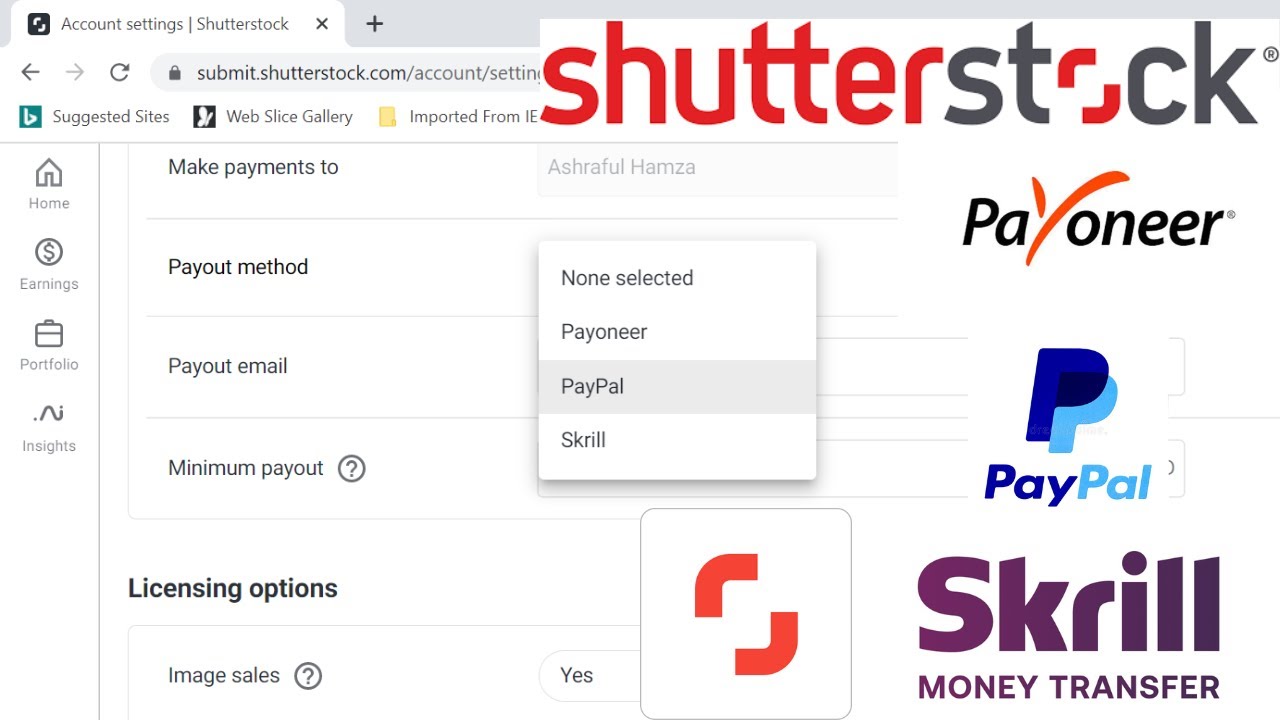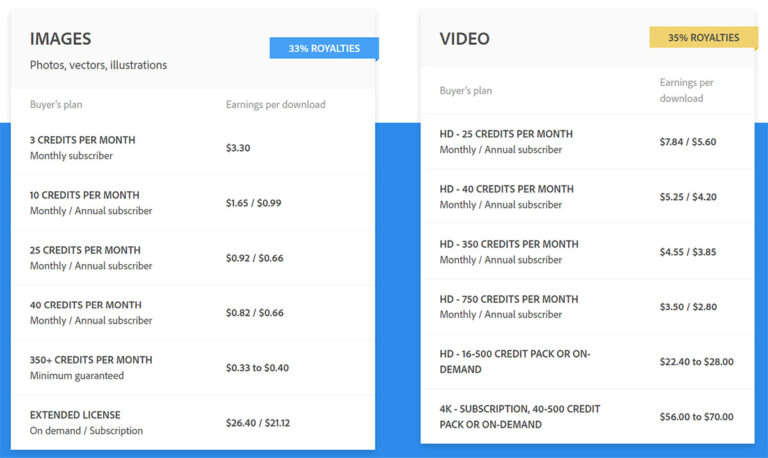Ever wondered how photographers and hobbyists turn their passion into profit? Selling your photos on Shutterstock can be a fantastic way to earn some extra income—or even a full-time living—if you play your cards right. Shutterstock is one of the biggest stock photo platforms out there, hosting millions of images from contributors around the globe. It’s accessible, relatively straightforward to get started, and offers a chance to showcase your work to a worldwide audience. But just how much money can you really make? Let’s dive into what it takes to sell photos on
Understanding Shutterstock’s Revenue Model for Contributors

To understand how much money you can earn, it’s essential to get a grasp of Shutterstock’s revenue model for contributors. Basically, Shutterstock pays you whenever your images are downloaded or viewed, but the exact amount depends on several factors. Here’s a quick breakdown:
- Royalty Rates: Shutterstock operates on a royalty system, meaning you earn a percentage of the sale price each time someone licenses your photo. The rate can vary from around 15% to 40%, depending on your contributor level and the type of license purchased.
- Contributor Levels: Shutterstock has a tiered system that rewards experienced contributors with higher earnings. New contributors start at a lower royalty rate but can increase their level over time based on their sales performance. The levels range from “Standard Contributor” to “Elite,” with each step offering better payout percentages.
- Payment Structure: Earnings accumulate in your Shutterstock account, and once you reach the minimum payout threshold (which is often around $35), you can request a payout via PayPal, Skrill, or bank transfer.
- Download and View Bonuses: While most earnings come from downloads (licenses purchased by clients), some views can generate smaller payouts, especially if your images are in high demand or go viral.
It’s also worth noting that the more popular your images become, the more you can earn per download. However, competition is fierce, and earning substantial income often requires consistently uploading high-quality, in-demand images. Building a diverse portfolio and understanding what buyers are looking for can significantly boost your earnings. So, while you might start earning just a few dollars per download, with persistence and strategic uploads, your income can grow over time—potentially turning your photography hobby into a steady income stream.
Factors Affecting Your Earnings on Shutterstock

When it comes to making money on Shutterstock, there’s no one-size-fits-all answer. Your earnings can vary widely depending on several key factors, and understanding these can help you maximize your potential income. So, what are the things that influence how much you can earn? Let’s break it down.
First off, the quality of your photos matters a lot. Shutterstock favors high-quality, sharp, well-lit images that are in demand. Think about what buyers are looking for—clear, professional photos that tell a story or fill a specific need. If your images are blurry, poorly composed, or over-edited, they’re less likely to sell, no matter how many you upload.
Next, the volume of your uploads plays a significant role. The more high-quality images you upload, the greater your chances of making sales. But it’s not just about quantity; it’s about consistent quality and relevance. Regularly updating your portfolio with fresh content can keep you in the spotlight and attract returning customers.
Another big factor is keywording and metadata. Properly tagging your images with relevant keywords helps buyers find your photos easily. Think about what someone searching for a particular scene or subject would use as search terms. The better your keywords, the more likely your images will appear in search results, leading to more sales.
Niche topics and trending subjects can also boost your earnings. If you focus on popular themes—like remote work, sustainability, or health—you might find a more receptive audience. Keeping an eye on current trends and capturing those moments can give your portfolio an edge.
Lastly, your contributor level impacts your earnings. Shutterstock has a tier system based on your sales volume, with higher tiers unlocking higher royalty rates. As you sell more images, you move up, earning more per sale. So, building a steady stream of sales is crucial for increasing your income.
In summary, your earnings are influenced by the quality and quantity of your images, how well you tag and categorize them, the relevance of your content, and your contributor level. Focusing on these factors can help you grow your income over time and turn your passion for photography into a profitable side hustle.
Average Income of Shutterstock Contributors

So, what can you realistically expect to earn from Shutterstock? Well, the truth is, it varies quite a bit. Some photographers make only a few dollars a month, while others are earning thousands. Let’s look at the averages to give you a clearer picture.
On average, new contributors might start earning around $0.25 to $1 per image sold. This might not sound like much, but remember, this is just the beginning. As you upload more images and improve your portfolio, your earnings can grow significantly.
Most contributors earn between $50 and $500 per month, especially once they have a sizable portfolio (say, 500+ images). For some, this becomes a reliable side income, while others might see it more as a supplement to their main job.
According to reports and surveys from contributors:
- Top performers can make over $10,000 per month if they have a large, high-quality portfolio focused on trending topics.
- Intermediate contributors often earn between $200 and $2000 per month as they build their portfolio and increase sales.
- Beginners tend to earn less than $50 to $100 initially, but with time and effort, income can grow.
It’s important to note that Shutterstock’s royalty rates depend on your contributor level and the type of license sold (standard vs. enhanced). Over time, as you reach higher tiers, your earnings per sale increase. For example, at the Elite contributor level, you might earn up to 30% royalty rate, compared to 15-20% at initial levels.
Remember, earning on Shutterstock is a marathon, not a sprint. Consistency, quality, and understanding what buyers want are key to growing your income. While some contributors earn a living wage, many treat it as a part-time gig that grows over time as they expand their portfolio and refine their skills.
In summary, the average earnings vary widely. With dedication and strategic effort, you can turn your photography hobby into a steady income stream—just keep uploading, learning, and adapting to market trends!
Tips to Maximize Your Earnings from Selling Photos
So, you’re ready to start earning money by selling your photos on Shutterstock—awesome! But how do you make sure you’re maximizing your earnings and standing out from the crowd? Here are some tried-and-true tips to help you get the most bang for your buck (or click!).
Focus on Popular and Trending Topics
One of the easiest ways to boost your sales is by shooting images that are in high demand. Think about what’s trending—seasonal themes, current events, or popular niches like health, technology, or lifestyle. Check Shutterstock’s trending categories regularly to see what buyers are searching for. Creating content around these topics can significantly increase your chances of making sales.
Maintain High-Quality Standards
Quality always wins. Make sure your photos are sharp, well-lit, and properly composed. Avoid overly busy backgrounds or distractions. Editing your images for brightness, contrast, and color balance can make a big difference. Remember, buyers are looking for professional-looking photos, so investing in good equipment and editing skills pays off in the long run.
Use Relevant and Specific Keywords
Keywords are how buyers find your images. Use descriptive, accurate, and specific keywords that truly represent your photo. Don’t just stuff your tags with popular words; instead, think about what someone searching for that image would type in. The more relevant your keywords, the higher your chances of showing up in search results.
Upload Consistently and Diversify Your Portfolio
Don’t put all your eggs in one basket. Regularly upload new images to keep your portfolio fresh and engaging. Also, diversify your content—cover different themes, styles, and subjects—so you appeal to a broader audience. The more diverse your portfolio, the more opportunities you have to make sales across various categories.
Engage with the Shutterstock Community
Join forums, social media groups, or communities of photographers. Sharing tips, feedback, and experiences can help you learn new strategies and stay motivated. Plus, engaging can sometimes lead to collaborations or insights into what buyers are really looking for.
Monitor Your Performance and Adjust
Keep an eye on which images sell the best and which don’t. Shutterstock provides analytics that show your top-performing photos. Use this data to adjust your future shoots—focus more on what works and improve or retire underperforming images. Continuous learning and adaptation are key to maximizing your earnings.
Steps to Get Started Selling Photos on Shutterstock
Getting started might seem daunting at first, but it’s pretty straightforward once you know the steps. Here’s a simple roadmap to launch your Shutterstock selling journey:
- Create a Contributor Account: Head over to Shutterstock’s contributor portal and sign up. You’ll need to provide basic info like your name, email, and payment details. Make sure to read their terms and conditions to understand their guidelines.
- Read and Understand Submission Guidelines: Shutterstock has specific rules about image quality, content, and metadata. Familiarize yourself with these to ensure your photos meet their standards. This includes technical specs like resolution (generally at least 4 MP), file format (JPEG), and no watermarks or logos.
- Prepare Your Photos: Select and edit your best images. Crop, enhance, and make sure they are sharp and professional-looking. Add relevant keywords and descriptive titles to make your images discoverable.
- Upload Your Photos: Use the contributor dashboard to upload your images. Fill out metadata accurately—titles, descriptions, and keywords. The more detailed and relevant, the better your chances of sales.
- Submit for Review: After uploading, your images go through Shutterstock’s review process. This typically takes a few days. They check for quality, originality, and compliance with guidelines.
- Monitor Your Portfolio and Sales: Once approved, your photos go live. Regularly check your dashboard for performance insights and sales data. Engage in continuous uploading and optimization to boost your earnings.
And that’s it! With a little effort and persistence, you’ll be building a portfolio that can generate passive income over time. Remember, the key is consistency, quality, and understanding what buyers want. Happy shooting and selling!
Conclusion and Final Thoughts on Earning Potential
In summary, selling photos on Shutterstock offers a promising opportunity for photographers to generate additional income. Your earning potential depends on several factors, including the quality of your images, the number of downloads, and your participation in exclusive or contributor programs. High-quality, unique, and in-demand photos tend to attract more buyers, increasing your earning prospects.
Key points to consider:
- Revenue Structure: Shutterstock pays contributors based on a tiered royalty system, with earnings ranging from 15% to 40% per download.
- Download Volume: The more your images are downloaded, the higher your potential earnings. Building a diverse portfolio can help reach broader audiences.
- Exclusive vs. Non-Exclusive: Exclusive contributors generally earn higher royalties but must limit their sales to Shutterstock, while non-exclusive contributors can sell elsewhere but at lower rates.
- Consistency and Quality: Regularly uploading high-quality images and staying active on the platform can lead to steady income streams over time.
While some top contributors earn a significant income, most creators see modest earnings initially. Success requires patience, dedication, and continuous improvement of your photography skills. Remember, earning from stock photography is not a guaranteed income but a potential revenue stream that can grow with effort and strategic portfolio management.
Ultimately, if you’re committed to producing compelling content and understanding the platform’s dynamics, selling photos on Shutterstock can be a rewarding side hustle or even a lucrative full-time endeavor.


